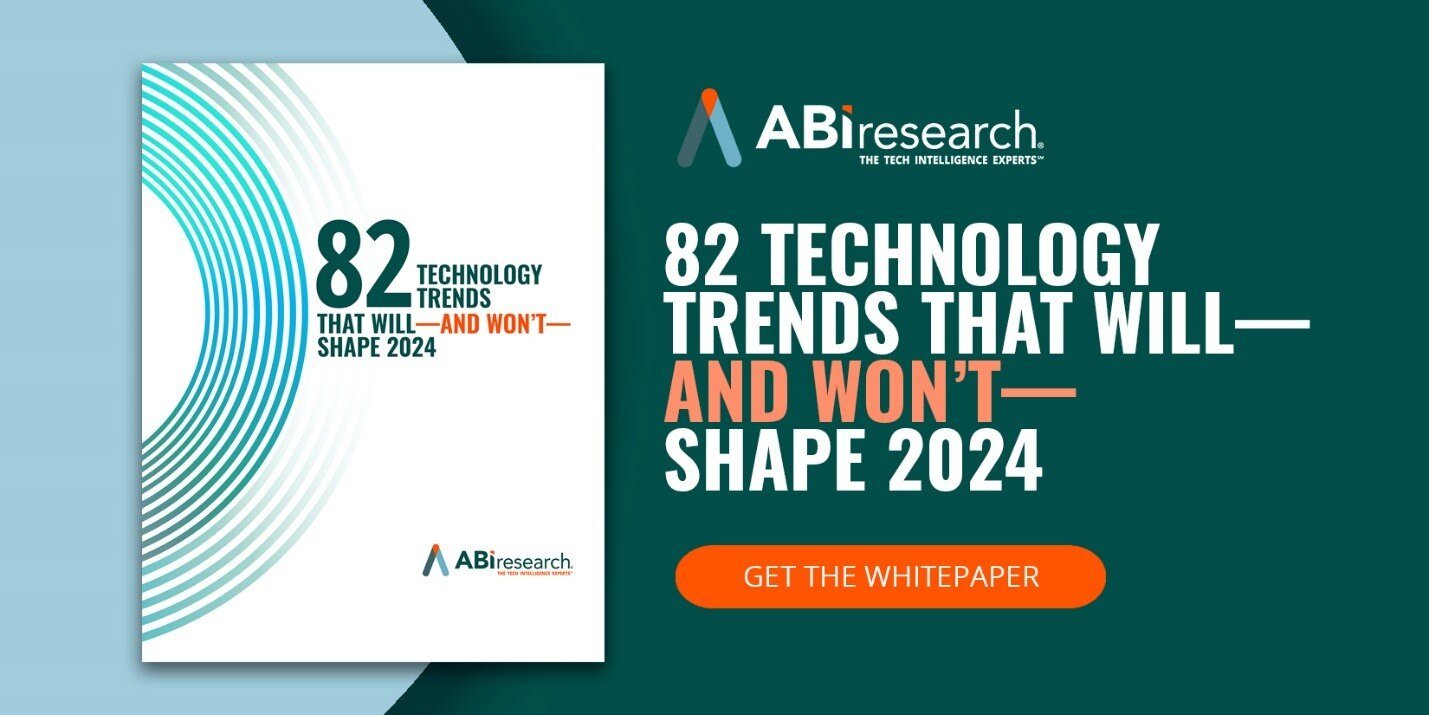Few technologies receive as much attention today as the Internet of Things (IoT). IoT adoption goes hand-in-hand with a company’s digitization efforts, providing actionable insight and real time data into operations. IoT devices and service use cases continue to expand and offer organizations essential data to improve how they do business. As solution providers compete with one another to differentiate their offerings, several IoT trends are emerging. Here are five of those key trends to track in 2024, as reported in ABI Research’s 82 Technology Trends That Will—And Will Not—Shape 2024. Before we look into our analysts’ future predictions, let’s review some of the most notable IoT statistics our analysts have compiled.
Key IoT Statistics
ABI Research analysts compile market data on various IoT topics. Here are some of the most striking statistics we have unearthed for the year 2024.
IoT Statistics for 2024
- There will be approximately 16.3 billion IoT connections worldwide, with China and the United States accounting for 40% of connections.
- The top three applications for IoT connections are home security & monitoring (10.9 billion connections), smart meters (1 billion connections), and home appliances (1 billion connections).
- IoT connections will generate US$18.6 billion in revenue.
- IoT data and analytics services revenue will total US$76.4 billion this year.
- IoT device and application platform services revenue will eclipse the US$100 billion mark.
- IoT network services will generate US$1.9 billion in revenue.
- IoT professional services firms will look at a US$83 billion market opportunity.
- IoT security services will create a US$10.4 billion revenue opportunity.
- Annual IoT antenna shipments will reach 6.8 billion in 2024.
Now, we look at some futuristic stats revealed from our market data reports.
Future IoT Statistics
- Growing at a Compound Annual Growth Rate (CAGR) of 16%, IoT connections will increase from 19.5 billion in 2025 to 40.1 billion in 2030.
- Annual IoT connection revenue will nearly double from US$21.4 billion in 2025 to more than US$40 billion by 2030, at a CAGR of 14%.
- Revenue from IoT data and analytics services will grow at a rate of 19% per year, increasing from US$91.9 billion in 2025 to almost US$218 billion by the end of the decade.
- Next year, IoT device and application platforms services will generate US$116 billion in revenue, surpassing the US$218 billion mark in 2030. This equates to a CAGR of 14%.
- IoT network services will represent a US$2.1 billion opportunity in 2025. Growing at a CAGR of 14%, that figure will more than double to US$4.1 billion by 2030.
- IoT professional services revenue will grow at a CAGR of 15% between 2025 and 2030, totaling US$189 billion by the end of the forecast window.
- By 2030, IoT security services will be a lucrative US$41.2 billion revenue market, with a CAGR of 25% from 2025.
Related Research
- Get more IoT stats by downloading ABI Research's IoT Market Tracker: Worldwide market data product.
- Learn how an IoT solution can remotely monitor the structural health of a mining site to prevent life-threatening incidents or how it can detect water leaks with IoT sensors to help conserve the limited amount of freshwater available for human consumption.
Trend #1: Tiny Machine Learning to Support Industrial IoT Applications
The year 2024 will see significant momentum for Industrial IoT (IIoT) innovation as enterprises seek machine monitoring applications and predictive maintenance capabilities. This year, Tiny Machine Learning (TinyML) will be a big IoT technology trend after 2 years of investment and acquisitions among sensor and software vendors. Helping drive adoptions, “killer apps” beyond video monitoring have been developed for TinyML, which is key for industrial use cases.
This year, we expect more machine builders, industrial automation vendors, and IoT solution providers to foster innovation for TinyML. By experimenting with TinyML, market players can identify the following:
- Best platforms available for TinyML-IoT fusion
- Where the value of TinyML is greatest in IIoT use cases
- How the technology can create new revenue streams
Trend #2: Investors Will Slow Their Financial Backing of Supply Chain IoT Platforms
The hype for IoT-based visibility technologies was immense between 2020 and 2022. This hype was spurred by the COVID-19 pandemic, geopolitical events, and increased traceability regulations. With the hype for supply chain technologies came a seemingly boundless level of financial backing for IoT visibility platforms. However, IoT solution providers should not expect the same treatment in 2024.
Investors were perhaps overly optimistic about short-term fortunes, as 2023 placed a dagger into the hype for supply chain visibility. Between last year’s shutdowns and rounds of layoffs at the biggest supply chain visibility platforms, investors are now more cautious about putting stock in the technology.
IoT solution providers targeting supply chains should now focus on improving product offerings and identifying synergies between visibility technologies and other vendors. Winning back investors' good graces today and in the future will require organizations to demonstrate the ability to offer a highly focused and innovative IoT solution.
Trend #3: Continued Use of Wired IoT Connections for Condition-Based Monitoring
Condition-Based Monitoring (CBM) involves IoT connectivity for measuring the performance and health of machines, equipment, warehouse facilities, transportation networks, containers, and many other critical assets. These applications enable organizations to identify maintenance issues before the problem is exacerbated, avoiding downtime. ABI Research’s analysts believe these critical CBM use cases will continue to rely on wired IoT connections in 2024. This IoT trend is driven by the need for robust connectivity solutions in high-critical environments (oil & gas, manufacturing, transportation, etc.).
Although it is true wireless IoT use cases have expanded for condition-based monitoring, they remain limited to low-critical assets. Wired IoT connections are more reliable than wireless, supporting continuous monitoring of assets and high data throughput. Rail operators, for example, will choose a wired IoT connection due to the risky nature of rail operations. Another key benefit of choosing wired connections is the fact that most industrial settings already have wired systems, easing the IoT installation process.
The future market for wireless IoT in CBM will still expand as telco infrastructure becomes more accessible and device technology improves. However, for the time being, wireless IoT will mostly be a complementary solution alongside other wireless solutions.
Trend #4: IoT MVNOs Look to the Consumer Markets
As IoT Mobile Virtual Network Operators (MVNOs) see their connectivity and management revenue share shrink, they are expected to expand to non-IoT use cases in 2024 and the coming years. This will help them compete better with their carrier partners and secure more connections. This shift in business focus means MVNOs must appeal to the consumer markets.
Consumer devices, such as smartphones, tablets, and laptops, typically generate higher Average Revenue per User (ARPU) because they usually produce more network traffic. Therefore, non-IoT use cases like travel-specific applications with Embedded Subscriber Identity Modules (eSIMs) and consumer device connectivity will provide MVNOs with new revenue streams/models.
Some of the pioneers in this space include Kajeet, Webbing, Transatel, and Giesecke+Devrient. These connectivity vendors have set the stage for other MVNOs to offer non-IoT services to complement their IoT portfolios this year and beyond.
Trend #5: Cat-1bis for IoT Devices
Cat-1 bis is essentially single-antenna Long Term Evolution (LTE)-based connectivity for the IoT. Compared to the dual-antenna Cat-1, Cat-1 bis makes it easier and cheaper to design compact IoT devices. ABI Research anticipates Cat-1 bis to begin showing its true potential in 2024.
A wave of chipset suppliers have brought Cat-1 bis chips to the market in the last few years. These semiconductor manufacturers—UNISOC, Eigencomm, ASR Microelectronic, Sequans (acquired by Renesas), and Qualcomm—are set to dominate the Cat-1 bis market. Any Cat-1 bis chips brought to market later this year and beyond will not see significant revenue due to module vendors and device Original Equipment Manufacturers (OEMs) choosing their chipset suppliers now. Cat-1 bis chipsets that hit the market in the early months of 2024 could potentially meet the window of opportunity.
It’s also worth noting there are no plans to iterate the Cat-1 bis standard, meaning a “second wave” of IoT modules and smart devices will not materialize in the future. The chipset suppliers that succeed now will succeed throughout the decade, as carriers will continue to use LTE for many years to come.
More Trends from ABI Research
ABI Research released its annual trends whitepaper, identifying 45 predictions of what will happen and 37 predictions of what will NOT happen in 2024. The IoT is one of the most transformative technologies our analysts cover, with services in four different areas. To better understand the future of the IoT and other technologies, download the whitepaper today.




